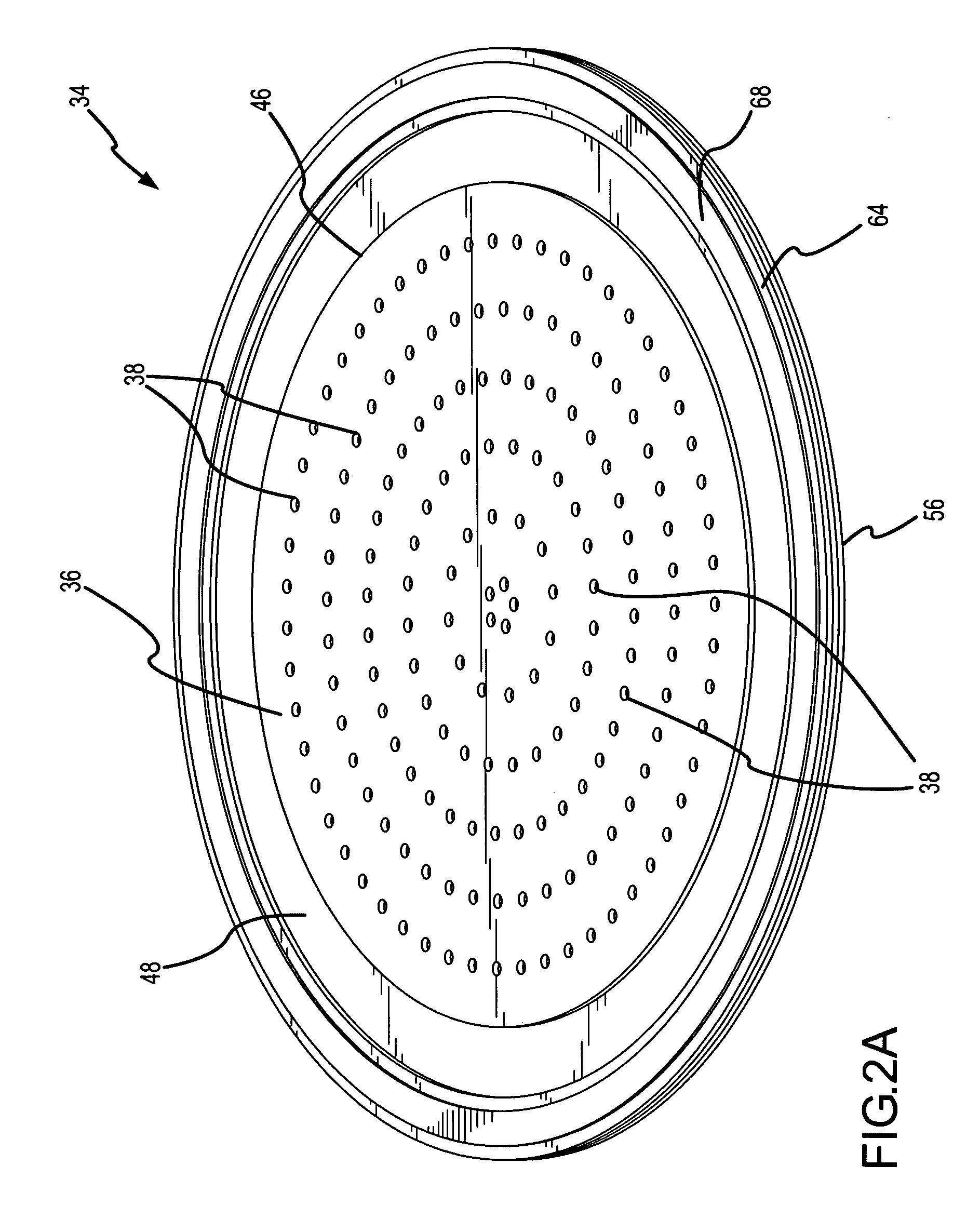[0008]Any appropriate coating may be applied to various surfaces of the MEMS flow module and / or any housing associated therewith, including without limitation a coating that improves biocompatibility, that makes such surfaces more hydrophilic, and / or that reduces the potential for bio-fouling. In one embodiment, a self-assembled monolayer coating (e.g., poly-ethylene-glycol) is applied in any appropriate manner (e.g., liquid or vapor phase, with vapor phase being the preferred technique) to all exposed surfaces of the MEMS flow module and any housing that integrates the MEMS flow module for positioning within the conduit.
[0032]Consider again the case where the second plate is spaced from the first plate in a first direction for the fourth embodiment of the MEMS flow module. The MEMS flow module may be oriented so that the first plate is on the high-pressure side of the MEMS flow module and so that the second plate is on the low-pressure side of the MEMS flow module. The second region of the second plate (e.g., an “inner” region) may flex at least generally in the first direction (or away from the first plate) in response to the development of at least a certain differential pressure across the MEMS flow module to change at least one dimension of the first flow restriction and / or decrease the flow resistance of the first flow restriction in a manner that accommodates an increased flow or flow rate through the MEMS flow module. The entire first plate may be at least substantially maintained in a fixed orientation (e.g., such that the entire first plate does not flex or otherwise change shape to any significant degree), or the second region of the first plate (e.g., an “inner” region) could also flex to at least a certain degree in the first direction, but not to the same extent as the second plate. Flexing of the first plate in this manner will still allow for a change in at least one dimension of the first flow restriction and / or a decrease in the flow resistance of the first flow restriction in a manner that accommodates an increased flow or flow rate through the MEMS flow module, but not to the same degree when compared to when the entire first plate remains in an at least substantially fixed orientation.
[0033]The fourth embodiment of the MEMS flow module could also be oriented so that the second plate is on the high-pressure side of the MEMS flow module and so that the first plate is on the low-pressure side of the MEMS flow module. The second region of the first plate (e.g., an “inner” region) may flex at least generally in a second direction that is opposite of the first direction (e.g., to move at least generally away from the second plate) in response to the development of at least a certain differential pressure across the MEMS flow module to change at least one dimension of the first flow restriction and / or decrease the flow resistance of the first flow restriction in a manner that accommodates an increased flow or flow rate through the MEMS flow module. The entire second plate may be at least substantially maintained in a fixed orientation (e.g., such that the entire second plate does not flex or otherwise change shape to any significant degree), or the second region of the second plate (e.g., an “inner” region) could also flex to at least a certain degree in the second direction, but not to the same extent as the first plate. Flexing of the second plate in this manner will still allow for a change in at least one dimension of the first flow restriction and / or a decrease in the flow resistance of the first flow restriction in a manner that accommodates an increased flow or flow rate through the MEMS flow module, but not to the same degree when compared to when the entire second plate remains in an at least substantially fixed orientation.
[0045]Various techniques may be employed to increase the rigidity of the first and / or second plate, for instance such that it remains in an at least substantially fixed orientation (e.g., such that it does not flex or otherwise change shape to any significant degree) when the MEMS flow module is exposed to the anticipated differential pressures. Two or more structural layers or films from adjacent fabrication levels could also be disposed in direct interfacing relation (e.g., one directly on the other) to increase the rigidity of the first and / or second plate. Over the region that is to define the first plate or second plate, this would require removal of at least some of the sacrificial material that is deposited on the structural material at one fabrication level before depositing the structural material at the next fabrication level (e.g. sacrificial material may be encased by a structural material, so as to not be removed by the release). Another option for increasing the rigidity of the first and / or second plate would be to maintain the separation between structural layers or films in different fabrication levels for the first plate and / or second plate, but provide an appropriate structural interconnection therebetween (e.g., a plurality of columns, posts, or the like extending between a third plate in a third fabrication level and either the first or second plate).
 Login to View More
Login to View More  Login to View More
Login to View More 


